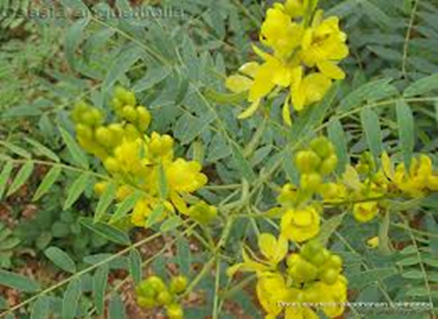Anthracene Glycosides
Content
• Source, diagnostic characters, constituents and
uses of Senna
Objectives
At the
end of this lecture, student will be able to
• Discuss the source, diagnostic characters,
constituents and uses of Senna
Anthracene glycosides
• Major class of glycosides
• Dicots – Euphorbiaceae, polygonaceae, Rhamnaceae,
rubiaceae etc
• Monocots – Liliaceae
• Fungi and lichens
• Lower plants – bryophytes, pteridophytes and gymnopserms –
devoid of glycosides
• Aglycone – Anthraquinone, anthrone, anthranol,
dianthranol, oxanthrone, dianthrone
• In some cases – derived form – Senna, aloe, rhubarb,
cascara, etc
• Reduced form – anthraquinone as anthranol (brownish
yellow) or anthrone (Plae yellow)
Borntrager’s test
• Anthraquinone glycosides
• Drug + Organic solvent – Organic layer made alkaline with
caustic soda or ammonia, aqueous layer shows pink, red or violet colour
• Anthranol – reduced form negative for borntrager’s test
Senna
Synonym
• Tinnevely senna, Alexandrain senna, Folia senna, Senna
leaf, Cassia senna
Source
• Dried leaflets of Cassia angustifolia (Indina
senna) and Cassia acutifolia (alexandrain senna)
Family
• Leguminosae
Morphology of Senna
• Type
• Colour
• Shape
• Size
• Odour
• Taste
• Petiole
• Margin
• Apex
• Base
• Venation
• Texture
Microscopy of Senna
• Paracytic stomata
• Covering trichome
• Isobilateral
• Lamina
• Upper epidermis
• Mesophyll
• Upper palisade
• Spongy parenchyma
• Lower palisade
• Lower epidermis
• Midrib
• Epidermal layers are continuous in the midrib
• Lower palisade is not in the midrib
• Collateral type
• Sclerenchymatous fibres
• Crystal sheath
Microscopy of Senna
Powder Characters of Senna
Organoleptic characters: Taste, Colour, odour, taste
• Covering trichome (unicellular)
• Paracytic stomata
• Calcium oxalate (Cluster/prisms)
• Epidermal cells
• Mesophyll
Active Constituents
• Glycosides: Anthracene – Dianthrone glycosides
Sennoside
A
Sennoside
B Homodianthrones
Sennoside
C
Sennoside
D Heterodianthrones
• Rhein, emodin, aloe emodin- aglycones
• Flavonoid- Kaempferol glycoside
Use
• Laxative in case of habitual constipation
Summary
• Senna is an isobilateral leaf
• Lamina is differentiated into upper epidermis, upper
palisade, spongy parenchyma, lower palisade and lower epidermis
• In midrib, the upper palisade in continuous whereas lower
palisade is interrupted with collenchyma
• Crystal sheath and sclerenchymatous sheath are found in
the midrib
• Senna contains anthracene types of glycosides



